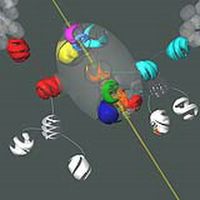Subatomic particles: An art form
This exposition is on canvas and paper but it could have been presented as touchable artifacts.
Sized Matter-Perception of the Extreme Unseen
Jan-Henrik Andersen
"While sciences propose and explain our world with measurable means, visual art and design offers intellectual and emotional appreciation of that which cannot be explained by any other means, measurable or not. This freedom from the constraints of scientific conventions may broaden our comprehension of our world, and I have taken great pleasure in freely bridging science with design - hopefully for the better of both as they are linked by beauty."

Top/Muon event from the Fermilab Tevatron
"The nature of the work is to lift the veil on the optically impossible task of visually observing subatomic particles by translating their properties and classification, known as the Standard Model of Subatomic Physics, into a coherent visual language. No one has ever seen, nor will anyone ever see anything as small or fast as a Quark or a Neutrino, one could argue that they could look like anything, if they have looks at all. On the other hand, a translation to visual aesthetics of their properties and behavior may offer a basis for a discussion of their visual qualities. The proposal as seen in the Fermilab Gallery, contextualize the particles in a syntax where properties like velocity, color, mass and spin is represented as visual elements within an order of itself. And perhaps yet more important; a visual perception of subatomic particles and their interaction may open this fantastic and beautiful world available to a broader audience."
Andersen, an assistant professor in the University of Michigan's School of Art & Design, is exhibiting "Sized Matter-Perception of the Extreme Unseen" through August at the Fermi National Accelerator Laboratory in Batavia, Ill.
Subatomic particles: An art form








